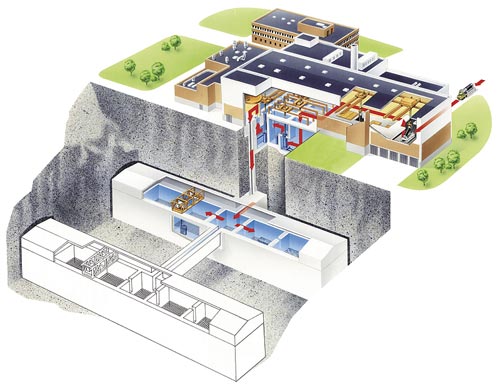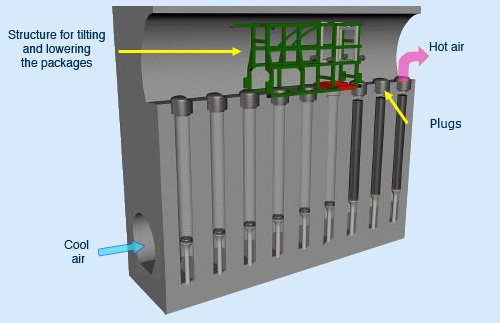Research into long-term storage
Research into long-term storage is the second research topic in area 3 under the Bataille Act and the new law passed in June 2006; the first topic in area 3 is conditioning.
The two topics are obviously linked. To be stored safely and be able to be recovered at the end of the storage period, packages must have been conditioned to the highest standard.

CLAB: a subsurface storage facility
There are countries that store spent fuels and high-level waste. What is different about this Swedish storage facility, CLAB, is that it is not very deep. Spent fuel is stored here under water. There is extensive monitoring of the items being stored, which are expected to be here for around thirty years at most. With storage for much longer periods, the issue arises of how to maintain the condition of the storage facilities.
© SKB
Storage is currently the rule both for spent fuel and for waste from reprocessing. The question is, can this storage on a scale of decades be extended for periods of up to 100 years, or even 300 years, in order to benefit from the reduction in the heat being released and in the radioactivity? These are quite long periods of time for society. The storage would have to be particularly secure.
According to France’s National Assessment Board (CNE ), the storage of high-level waste packages, as practised at La Hague, ‘appears to meet all the requirements that could reasonably be demanded of it. It could be extended for an unspecified length of time – perhaps seventy or a hundred years – if an extra wing were built at La Hague, in a large room with something like manhole covers, with the waste beneath them‘.
), the storage of high-level waste packages, as practised at La Hague, ‘appears to meet all the requirements that could reasonably be demanded of it. It could be extended for an unspecified length of time – perhaps seventy or a hundred years – if an extra wing were built at La Hague, in a large room with something like manhole covers, with the waste beneath them‘.
Storage for periods of more than a century would undoubtedly require constant monitoring and high levels of maintenance, or even the periodic rebuilding of the facility. There would also be the maintenance of the metal structures; the construction industry is not prepared to guarantee concrete for more than a hundred years; and then there is the unknown factor of social stability.
Storage for a reasonable period offers the advantage of reducing the size of the disposal facilities to be built, and provides an opportunity to benefit from technological advances and to wait for reactors to come on the scene that can burn certain waste. Extending storage times beyond a reasonable period would place a burden on future generations for which they would surely not thank us…

Cooling by natural convection
Spent fuel and high-level waste are hot, though their heat diminishes considerably over time. When this waste is in storage, the released heat has to be removed. Over very long periods of time and with limited monitoring, it would not be possible to rely on cooling in a pool. Dry cooling, by natural convection, would have to be used. The packages would be stacked in shafts. The air would circulate passively due to the stack effect.
© CEA
What materials will be needed for these facilities? What infrastructure needs to be designed? Should they be built as surface or subsurface facilities? How do we ensure they are monitored?
CEA’s engineers and researchers at Marcoule in Gard have a facility (CECER or the Centre for the development and the technological demonstration of containment and long term storage systems) that enables them, using a model, to study the operation of the storage drifts, the air circulation and the removal by convection of the heat released by the packages, and also allows them to carry out research into the durability of the concrete.
The design of a long-term storage facility is based on three criteria: robustness, reversibility and passivity.
– 1) Robustness: Guaranteeing the containment of the radioactive materials despite earthquakes, floods, human intrusion and the ageing of the components.
– 2) Reversibility: Guaranteeing the integrity of the packages and the possibility of removing them at any time.
– 3) Passivity: Relying on nature and not on humanity for the running of the facility and minimising the monitoring workload placed on future generations.
Environmentalists opposed to the disposal of the waste, often with the backing of politicians, suggest long-term storage as an alternative. Is it a wise suggestion? Can we really bequeath the maintenance and monitoring of these facilities to our distant descendants? What would we say if we had to maintain storage facilities from the time of Louis XV or Napoleon III?
We should remember that the storage of high-level waste would not be a substitute for deep geological disposal or prior transmutation. According to Bernard Tissot, Chair of the National Assessment Board, ‘used for too long, the best of storage facilities becomes the worst of disposal facilities’.
TO KNOW MORE ABOUT PROSPECTS OF INTERIM STORAGE :
– 1) : How long intermediate storages?
Other articles on the subject « Waste Outlooks »
Three research areas
Three complementary research areas The three research areas under the Bataille Act, later supplem[...]
Area 1: Partitioning
Sorting the radioelements in radioactive waste The separation, or partitioning, of the radioactiv[...]
Partitioning: results
Development of processes and extractant molecules The 2006 assessment of research into partitioni[...]
Advanced partitioning
Partitioning of nuclear waste: hot chemistry Advanced partitioning goes beyond just the partition[...]
Area 1: Transmutation
Area 1: Transmuting or transforming radioactive atoms Transmutation is the second part of researc[...]
Transmutation facilities
Fast reactors and Accelerator Driven Systems (ADS) The neutron, which easily penetrates nuclei, i[...]
Transmutation prospects
A far away objective for Generation IV and 2040… At the time of the first tests on the tran[...]
Area 2: Disposal
Research into deep geological disposal Can the nuclear industry’s final waste, which we cur[...]
Long surface storage concepts
Long-term surface and subsurface storage Research into very long-term storage is a matter for the[...]
Area 3: Conditioning
Area 3: Research into conditioning The conditioning of high-level and intermediate-level waste is[...]